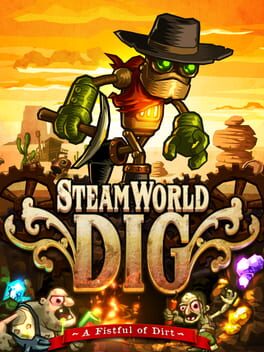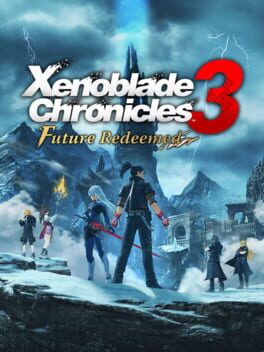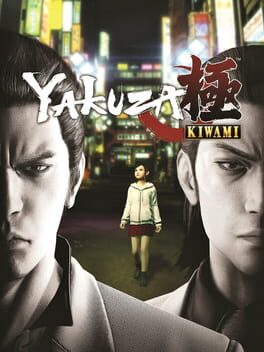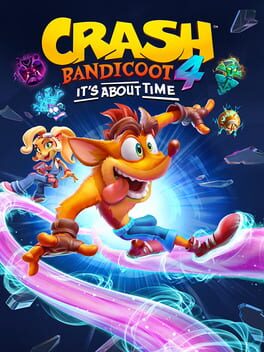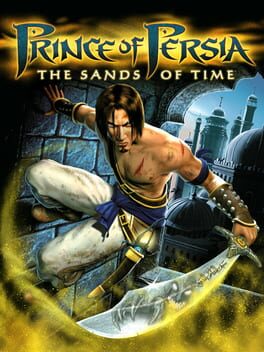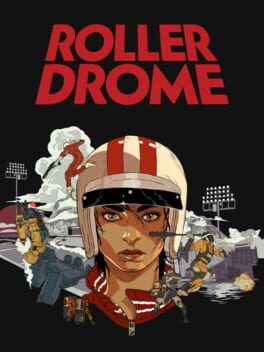Gerborious
2007
2021
2013
I'm pretty confident that SteamWorld Dig is one of the first indie games I ever played. If my memory is correct, the first was Cave Story, and I'm pretty sure that SteamWorld Dig is within the first ones I got on my 3ds. Point being, I wanted to return to the game for a little bit of a nostalgia trip.
Luckily, I think this holds up really well! It sits at the intersection of Dig Dug, Mr. Driller, Terraria, and a little bit of Metroid. I think most people would accept the first three influences, but there may be some debate on whether or not this qualifies as a search action game.
I really love the main gameplay loop of mining. The restrictions on your capabilities, namely how you cannot dig across a layer above you brings a lot of thought to each movement you make. As the game progresses, and unique obstacles are added, the game only becomes more dynamic. The various caves, while less interesting in my opinion, help punctuate the gameplay. The upgrades you collect across the game also do a good job at expanding your possibility space.
Ultimately Steamworld Dig does a great job at applying an arcade style gameplay loop into a short but featured campaign.
Luckily, I think this holds up really well! It sits at the intersection of Dig Dug, Mr. Driller, Terraria, and a little bit of Metroid. I think most people would accept the first three influences, but there may be some debate on whether or not this qualifies as a search action game.
I really love the main gameplay loop of mining. The restrictions on your capabilities, namely how you cannot dig across a layer above you brings a lot of thought to each movement you make. As the game progresses, and unique obstacles are added, the game only becomes more dynamic. The various caves, while less interesting in my opinion, help punctuate the gameplay. The upgrades you collect across the game also do a good job at expanding your possibility space.
Ultimately Steamworld Dig does a great job at applying an arcade style gameplay loop into a short but featured campaign.
2005
Xenoblade Chronicles 3 was easily my favorite game of 2022, and while Future Redeemed didn't exceed expectations for me, I'm absolutely not disappointed. Despite being a prequel, this really feels like a conclusion; to a story, to an artist's ambition, to my own personal journey.
Matthew is the best.
A is simultaneously the best.
Rex finally beat the dripless allegations.
Shulk is my dad.
Nikol and Glimmer are also there. (Complimetary)
Thank you Takahashi & Monolith Soft.
Matthew is the best.
A is simultaneously the best.
Rex finally beat the dripless allegations.
Shulk is my dad.
Nikol and Glimmer are also there. (Complimetary)
Thank you Takahashi & Monolith Soft.
2007
I actually didn't realize that Detective Grimoire: Secret of the Swamp was a sequel to an original flash game. Luckily, I already had flashpoint installed, so I figured that checking out the original likely wouldn't be a waste of time.
Yeah, this is definitely a flash game alright. Animations include a lot of obvious tweening, the voice over has a couple of Newground's elites, and the gameplay is very simple. Honestly, for the time and environment that it was made in, I think it works rather well.
Yeah, this is definitely a flash game alright. Animations include a lot of obvious tweening, the voice over has a couple of Newground's elites, and the gameplay is very simple. Honestly, for the time and environment that it was made in, I think it works rather well.
2016
A lot of people have really strong criticism of Kiwami, that I can't really confirm or deny. I haven't played the original Yakuza (or Yakuza 2 for that matter), so I can only view Kiwami within it's own context.
It's fine! I like Kiryu, I like how he feels to play. I enjoyed the story well enough. It just didn't wow me like 0 did, and I felt the unique systems for Kiwami (Majima everywhere, Kiwami actions) were really annoying.
It's fine! I like Kiryu, I like how he feels to play. I enjoyed the story well enough. It just didn't wow me like 0 did, and I felt the unique systems for Kiwami (Majima everywhere, Kiwami actions) were really annoying.
2022
Live A Live is one of the most joyful games I have ever played. It carries a playful attitude towards game design that many of the games that inspired me as a child did.
Every single chapter features a new setting, mechanical addition, structural twist, or tone of storytelling. One chapter features a detailed crafting system, another is centered around a complex training system, and one acts as a template for RPG maker horror games two years before the original release of Corpse Party.
I left Live A Live feeling invigorated and inspired; as the credits rolled and I thought about the game in its entirety, my mind was racing with game design ideas to explore on my own in the future. I've been actively working on ideas for a game inspired by the Wild West chapter in particular, but I think that discussion would be best left for when I actually make it.
Truly a wonderful game.
Every single chapter features a new setting, mechanical addition, structural twist, or tone of storytelling. One chapter features a detailed crafting system, another is centered around a complex training system, and one acts as a template for RPG maker horror games two years before the original release of Corpse Party.
I left Live A Live feeling invigorated and inspired; as the credits rolled and I thought about the game in its entirety, my mind was racing with game design ideas to explore on my own in the future. I've been actively working on ideas for a game inspired by the Wild West chapter in particular, but I think that discussion would be best left for when I actually make it.
Truly a wonderful game.
Absolutely insane how every time a new team brings an old platforming series out of the vault they manage to make one of, if not the best game in their respective series. First there was Donkey Kong Country, then Rayman, and now Crash.
Crash 4 gets as close to a 3D precision platformer as a mainstream title is likely ever going to get. I doubt that Nintendo would ever dare to try, and Sonic has gone open zone at this point, so that ship has sailed. Such an undertaking, no matter how well done it is, has some rough edges. Crash 4 is tight, definitely more consistent than the N.Sane Trilogy, but when the game asks for perfect precision, this just doesn't hold up. Additionally, the game could remove at least a few crates every level and be better off for it. Once the player knows to check behind walls, or above every stack of crates it's no longer an interesting secret. Especially when it's repeated so often.
The additional gimmicks are all pretty good! Aside from Tawna funnily enough, because of her similarities she just ends up feeling like a less engaging version of the core gameplay. Also, while Cortex and Dingodile are both fun, some of their levels are absurdly short. I know it isn't possible to divide game development like this, but I would've preferred the alternate timeline stages be cut entirely, and each character get an additional, entirely unique stage instead.
What I'm left with is a sense of expectation. I firmly believe that if this team got one more shot at making a sequel, we wouldn't just have the best Crash game on our hands, we would have one of the best platformers ever made. Donkey Kong and Rayman both had that opportunity, why not Crash?
Crash 4 gets as close to a 3D precision platformer as a mainstream title is likely ever going to get. I doubt that Nintendo would ever dare to try, and Sonic has gone open zone at this point, so that ship has sailed. Such an undertaking, no matter how well done it is, has some rough edges. Crash 4 is tight, definitely more consistent than the N.Sane Trilogy, but when the game asks for perfect precision, this just doesn't hold up. Additionally, the game could remove at least a few crates every level and be better off for it. Once the player knows to check behind walls, or above every stack of crates it's no longer an interesting secret. Especially when it's repeated so often.
The additional gimmicks are all pretty good! Aside from Tawna funnily enough, because of her similarities she just ends up feeling like a less engaging version of the core gameplay. Also, while Cortex and Dingodile are both fun, some of their levels are absurdly short. I know it isn't possible to divide game development like this, but I would've preferred the alternate timeline stages be cut entirely, and each character get an additional, entirely unique stage instead.
What I'm left with is a sense of expectation. I firmly believe that if this team got one more shot at making a sequel, we wouldn't just have the best Crash game on our hands, we would have one of the best platformers ever made. Donkey Kong and Rayman both had that opportunity, why not Crash?
2023
I am completely on board for more remakes that are both completely distinct from the original, and equally excellent. I get being disappointed with certain aspects being removed, but at the same time I love what they added and remixed here. Can't believe I'm going to have to choose between two RE4s to replay for the rest of my life, woe is me.
2001
I remember this game feeling distinctly threatening to me when I was young. I wasn't used to making precise movements under pressure with the Wii pointer so things were rough for 8 year old me.
I think because of that history though I've grown very fond of Pikmin 1. I love the atmosphere, how the game is willing to only use ideas once, and how it encourages multiple playthroughs.
Playing through it again without any form of motion control, I've also found myself in love with controlling the Pikmin themselves. They're distinctly clumsy and disobedient, and the game uses that friction brilliantly. Managing your Pikmin is like herding cats, and the frustration that causes? That's where the soul is, the soul in the code!
My admiration for Pikmin 1 grows each time I replay it.
I think because of that history though I've grown very fond of Pikmin 1. I love the atmosphere, how the game is willing to only use ideas once, and how it encourages multiple playthroughs.
Playing through it again without any form of motion control, I've also found myself in love with controlling the Pikmin themselves. They're distinctly clumsy and disobedient, and the game uses that friction brilliantly. Managing your Pikmin is like herding cats, and the frustration that causes? That's where the soul is, the soul in the code!
My admiration for Pikmin 1 grows each time I replay it.
I highly doubt that I share much in common with Shigeru Miyamoto. We come from different generations, cultures, and likely diverge on how we view games as a medium. One thing that I do know we share is a fascination with exploration, reaching all the way back into our childhoods.
One of my favorite activities as a child was to "trek the creek", where I would put on large rubber boots multiple sizes too large and wander into the forest behind my home. I would follow the small steam for what seemed like miles, going as far as I could until something seemed insurmountable; after which I would turn around and head back home.
One of the most commonly recounted creation myths in games is that of The Legend of Zelda, how Miyamoto's adventures around his own childhood home inspired the spirit of this legendary series.
Breath of the Wild was not directed or designed by Miyamoto, it's truly unknown how much say he actually had in the project. What is known is the game's intent; to recapture that original free spirit. To create a game in which players could wander, and create their own adventure.
I still remember when I found a waterfall on one of my treks up that creek. It was late in a summer afternoon, the sun that found its way though the trees bounced off the water to make it appear almost golden. I've never returned to it, I doubt that the reality would stand up to my idyllic memories, but I don't care. The way it exists in my mind is enough.
Breath of the Wild brought new life to a series that had grown stale. It does so by honoring the original inspiration for the series. Before it was a series about narrative and puzzles, there was only a world to explore and the will to explore it for it's own sake. It's one of a very few games to ever capture that feeling I felt while wandering in the woods during my youth. The way it exists in my mind is enough.
One of my favorite activities as a child was to "trek the creek", where I would put on large rubber boots multiple sizes too large and wander into the forest behind my home. I would follow the small steam for what seemed like miles, going as far as I could until something seemed insurmountable; after which I would turn around and head back home.
One of the most commonly recounted creation myths in games is that of The Legend of Zelda, how Miyamoto's adventures around his own childhood home inspired the spirit of this legendary series.
Breath of the Wild was not directed or designed by Miyamoto, it's truly unknown how much say he actually had in the project. What is known is the game's intent; to recapture that original free spirit. To create a game in which players could wander, and create their own adventure.
I still remember when I found a waterfall on one of my treks up that creek. It was late in a summer afternoon, the sun that found its way though the trees bounced off the water to make it appear almost golden. I've never returned to it, I doubt that the reality would stand up to my idyllic memories, but I don't care. The way it exists in my mind is enough.
Breath of the Wild brought new life to a series that had grown stale. It does so by honoring the original inspiration for the series. Before it was a series about narrative and puzzles, there was only a world to explore and the will to explore it for it's own sake. It's one of a very few games to ever capture that feeling I felt while wandering in the woods during my youth. The way it exists in my mind is enough.
2022
This was a very pleasant surprise! I wasn't very interested going into it, so it did end up exceeding my expectations.
This game shines when it allows you the freedom to explore. The more open levels are both densely populated with detail, but also have many intertwining paths and things to find. I felt extremely satisfied when I was able to find an item early, and then have it become relevant after returning to that area later. Unfortunately, a lot of the runtime is spent in more linear sections. These are fine, and still maintain the wonderful art direction, but I don't think they play to Stray's strengths.
This game shines when it allows you the freedom to explore. The more open levels are both densely populated with detail, but also have many intertwining paths and things to find. I felt extremely satisfied when I was able to find an item early, and then have it become relevant after returning to that area later. Unfortunately, a lot of the runtime is spent in more linear sections. These are fine, and still maintain the wonderful art direction, but I don't think they play to Stray's strengths.
Prince of Persia: The Sands of Time is without question one of the most influential platformers ever made. It's easy to trace its legacy during play. Moments where ledges fall away, revealing a specific path for the Prince to climb on, or removing pieces of scaffolding that the player balances on have been redone again and again and again. Uncharted, God of War, Tomb Raider, Jedi: Fallen Order, and many more all follow in the example that this game set, if in an extremely diluted way. So, does this original version stand up to the test of time? I would say it does fairly well.
What The Sands of Time has over most modern instances of this style is obscuration. While the Prince is much more agile than say, Nathan Drake, I think this aspect of the level design is much more active in creating engaging platforming. This is a puzzle platformer in a literal sense, where the button combinations and reaction times are pretty lenient, so the challenge is derived from pathfinding. The best parts of The Sands of Time are when it crafts a fully realized puzzle box of platforming. Spaces that are well realized enough to facilitate a sense of place, alongside engaging the player in solving the path forward. Ropes, columns, ledges, saws, beams, and more are dotted around rooms, and the player's job is to string these separate elements together into a traversable path. It helps, of course, that the contextual tools the player does have are satisfying to pull off.
As mentioned before, The Sands of Time is a pretty relaxed game in terms of the platforming. It could use some development, but it's a really good base to work off of, and if it was the only aspect of The Sands of Time I would probably be able to heartily recommend it. Luckily, the combat of this game is here to save the day! I get why it exists, this is a tale of swashbuckling adventure! White knuckle platforming, and acrobatic life or death combat! Unfortunately, the mechanics aren't up to snuff.
So, every once in a while, usually after an extended platforming section, the game will throw you into a combat arena. Usually, there are a few enemies idling, but stealth isn't an option. Unlike other games, you can't just defeat the enemies by dealing enough damage. You need to knock them down with standard attacks, before absorbing them into your knife, which is a prolonged animation. You have a button to attack, another to use the knife, the jump now vaults the Prince over an enemy or off a wall, and there are a few special techniques that take resources. It sounds good on paper, a simple combat system to act as a nice buffer between sections of the real meat of the game, but combat scenarios feel long, tedious, and unbalanced. The only impactful difference between enemies is that some punish the Prince for attempting to vault over them. Because the Prince selects which enemy to target on his own, I got game overs numerous times when he decided to absorb an enemy instead of freezing another. The time rewind mechanic has a strange restriction in combat, where defeating an enemy resets the clock. So if an enemy starts an attack while you are absorbing another, and you are able to finish, you take unavoidable damage from the Prince's lengthy recovery frames. Sometimes certain moves don't seem to work, your companion is actively unhelpful, and the camera feels the need to give the player as little helpful information as possible. All of this combines into one of the least enjoyable combat systems I have played in a long time.
I don't want to end this on a negative note. I really did enjoy my time overall with The Sands of Time. Yes, the combat is not good, and the story isn't anything worth talking about (The Prince is straight up misogynistic, the guy literally at one point says the female lead needs to learn her place and he needs to conquer her it's weird), but it does have a good base to work off of. I am excited to see where the series goes from here. Even if the sequel looks entirely unappealing.
What The Sands of Time has over most modern instances of this style is obscuration. While the Prince is much more agile than say, Nathan Drake, I think this aspect of the level design is much more active in creating engaging platforming. This is a puzzle platformer in a literal sense, where the button combinations and reaction times are pretty lenient, so the challenge is derived from pathfinding. The best parts of The Sands of Time are when it crafts a fully realized puzzle box of platforming. Spaces that are well realized enough to facilitate a sense of place, alongside engaging the player in solving the path forward. Ropes, columns, ledges, saws, beams, and more are dotted around rooms, and the player's job is to string these separate elements together into a traversable path. It helps, of course, that the contextual tools the player does have are satisfying to pull off.
As mentioned before, The Sands of Time is a pretty relaxed game in terms of the platforming. It could use some development, but it's a really good base to work off of, and if it was the only aspect of The Sands of Time I would probably be able to heartily recommend it. Luckily, the combat of this game is here to save the day! I get why it exists, this is a tale of swashbuckling adventure! White knuckle platforming, and acrobatic life or death combat! Unfortunately, the mechanics aren't up to snuff.
So, every once in a while, usually after an extended platforming section, the game will throw you into a combat arena. Usually, there are a few enemies idling, but stealth isn't an option. Unlike other games, you can't just defeat the enemies by dealing enough damage. You need to knock them down with standard attacks, before absorbing them into your knife, which is a prolonged animation. You have a button to attack, another to use the knife, the jump now vaults the Prince over an enemy or off a wall, and there are a few special techniques that take resources. It sounds good on paper, a simple combat system to act as a nice buffer between sections of the real meat of the game, but combat scenarios feel long, tedious, and unbalanced. The only impactful difference between enemies is that some punish the Prince for attempting to vault over them. Because the Prince selects which enemy to target on his own, I got game overs numerous times when he decided to absorb an enemy instead of freezing another. The time rewind mechanic has a strange restriction in combat, where defeating an enemy resets the clock. So if an enemy starts an attack while you are absorbing another, and you are able to finish, you take unavoidable damage from the Prince's lengthy recovery frames. Sometimes certain moves don't seem to work, your companion is actively unhelpful, and the camera feels the need to give the player as little helpful information as possible. All of this combines into one of the least enjoyable combat systems I have played in a long time.
I don't want to end this on a negative note. I really did enjoy my time overall with The Sands of Time. Yes, the combat is not good, and the story isn't anything worth talking about (The Prince is straight up misogynistic, the guy literally at one point says the female lead needs to learn her place and he needs to conquer her it's weird), but it does have a good base to work off of. I am excited to see where the series goes from here. Even if the sequel looks entirely unappealing.
2022
The premise for Rollerdrome is absurd on the surface, but it is actually incredibly indicative of the game's design philosophy.
Rollerdrome, simply, is the most unique interpretation of the movement shooter that we've seen yet. Where most games in the subgenre (Doom Eternal, Quake, Ultrakill, etc.) rely upon similar modes of transport, Rollerdrome flips the script. Instead of iterating and expanding upon FPS controls (a movement shooter), it brings shooting to the base of skating games (a movement shooter).
The entire game is so tightly designed from start to finish, and you can see all it has to offer within a few hours. The game then leaves the decision on whether to push the combat to it's limits up to the player. It's a killer game in every way.
Rollerdrome, simply, is the most unique interpretation of the movement shooter that we've seen yet. Where most games in the subgenre (Doom Eternal, Quake, Ultrakill, etc.) rely upon similar modes of transport, Rollerdrome flips the script. Instead of iterating and expanding upon FPS controls (a movement shooter), it brings shooting to the base of skating games (a movement shooter).
The entire game is so tightly designed from start to finish, and you can see all it has to offer within a few hours. The game then leaves the decision on whether to push the combat to it's limits up to the player. It's a killer game in every way.


